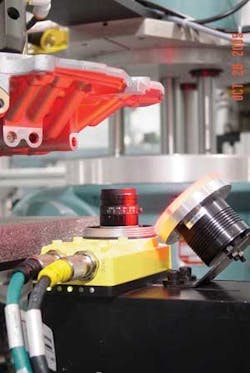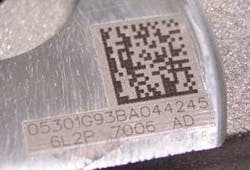Manufacturers worldwide are reducing production costs, increasing product safety, and ensuring customer satisfaction with traceability systems
Robin Barbero
For many manufacturers, recent federal regulations on product and part traceability have placed new demands on their production process. Compliance with the TREAD Act, RoHS, and SPEC 2000 has caused concern and sent companies scrambling to meet these industry and governmental requirements.
Industry guidelines have been in place for years. SPEC 2000, for instance, includes standards and specifications for traceability technologies like barcoding, 2D data matrix symbologies, and RFID (radio frequency identification). Indeed, over the last 30 years product traceability has seen widespread deployment across many different industries, including automotive, medical, aerospace, and military.
The TREAD Act represents the government’s answer to traceability deficiencies in the automotive industry. This law was signed into effect on November 1, 2000. It represents the most significant expansion of the U.S. Vehicle Safety Act in 25 years. Specifically, the TREAD Act requires manufacturers of motor vehicles and motor vehicle equipment to report information on parts derived from both foreign and domestic sources. This information must assist in the identification of any defects related to motor vehicle safety.
In parallel to this regulatory structure is the overarching desire for quality control by manufacturers. Traceability technology provides companies with a tool that proactively contains product deficiencies. Through the implementation of traceability systems they can minimize the cost of product recalls. Couple this with enhanced technology and manufacturers can actually eliminate the need for recalls altogether. The cost savings realized by avoiding just one large recall is usually enough to pay for a traceability system many times over.
Even more compelling, however, is the end result with the customer. Given the constant publication of satisfaction reports and studies, the ultimate effect of minimizing quality issues is best realized in the customer’s approval. This, more than anything else, can ultimately make or break a product. Customer happiness can literally mean billions of dollars to manufacturers.
Given the demands of a regulated manufacturing environment, a driving need for better quality control, and a relentless desire to increase customer satisfaction, traceability systems look to play an increasing role in manufacturing processes. While many systems exist for enacting traceability, fiber lasers represent a substantial improvement for part marking and will soon take a prominent role in this effort.
Case study
Metaldyne is an automotive parts manufacturer based in Plymouth, Michigan. The company designs and supplies components and modules for engine, driveline, and chassis applications. Metaldyne has 45 facilities worldwide and employs in excess of 7,500 people. It works with a diverse customer base, including U.S. and foreign automakers.
The company has launched a new, high-volume, non-synchronous assembly line designed to assemble and test an aluminum transmission cover assembly. It integrated Precision Technology Group’s (PTG; Lake Mary, FL; www.ptgindustries.com) fiber laser systems into its line. The fiber laser systems proved to be far less costly to operate and substantially more accurate than competing CO2 and Nd:YAG laser systems (see sidebar). The laser is tasked with marking human-readable and barcoded information, including Julian dates, serial numbers, supplier codes, and part number data.
Integrated with the laser systems is a Cognex vision system that ensures the marks are correct and legible. A computer then analyzes important production data that is reconciled to each individual part. If any defects are found during quality inspection, Metaldyne can quickly recall other suspect parts from a specific manufacturing lot based upon the traceability serial numbers.
Metaldyne is focused on total quality, which means quality at all levels of the manufacturing process. By focusing on total quality, the company is able to lower the overall costs of production. The enhanced documentation and reporting on the parts limits the company’s litigious liability and promotes strict adherence to both customers’ and the government’s regulations. Most importantly, however, is Metaldyne’s increased assurance that what it makes will satisfy the end-user by utilizing the mark as a platform to enhance its quality control efforts.
Robin Barbero is VP sales and marketing at PTG Industries, Lake Mary, FL, www.ptgindustries.com. Troy Lee, sales manager PTG Industries, assisted in compiling this article.
Traceability at the speed of light
Many lasers have been sold over the past decade with the sole intent of marking parts. Manufacturers quickly discovered that there was a lot to like about laser marking. Lasers are versatile in terms of project setup, implementation, and completion. Also, seemingly any type of material could be marked precisely with a laser.
Both CO2 and Nd:YAG lasers have proven effective and flexible in application but expensive to maintain and operate. Therefore, many of the practical benefits of laser technology are offset by the amount of capital required to keep them working.
Fiber lasers, however, represent the state of the art in laser marking technology. As such, ease of use and maintenance-free operation is designed into the daily use of these systems. In fact, when combined with powerful software, fiber lasers offer manufacturers a more cost-efficient and effective alternative.
In operation, the beam travels down a fiber cable and is fed into a collimator. It is then relayed into a scan head and is output to the material being marked. The simplicity of this design significantly reduces total cost of ownership because there is no need to re-align the optical path. Other features include high efficiency, an M2 beam quality of 1.05, an MTBF of 50,000 to 100,000 hours, and a laser beam spot size that is approximately 50 percent smaller with a Q-switch fiber laser and smaller still for a CW fiber laser, compared to CO2 and Nd:YAG lasers.
Market adoption of fiber lasers is growing at a rapid pace. The fiber laser technology is projected to grow to nearly 20 percent of lasers sold by the year 2007. Fiber lasers can transfer marks on items using alphanumerics, logos, serial numbers, part numbers, lot codes, date codes, schematics, and virtually any graphical art. Furthermore, a vast array of materials can be processed with fiber lasers, including stainless steel, aluminum, anodized aluminum, carbide, polycarbonates, titanium, nickel, plastics, and chrome.

